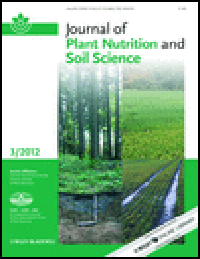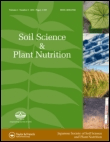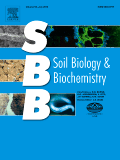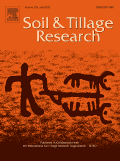
Frontiers in Soil Science
Scope & Guideline
Unlocking the secrets beneath our feet.
Introduction
Aims and Scopes
- Soil Health and Fertility:
Research on soil health encompasses studies on nutrient dynamics, soil organic matter, and the impact of different agricultural practices on soil fertility and productivity. - Soil Microbiology and Ecology:
Investigations into soil microbial communities, their interactions with plants, and their role in nutrient cycling and ecosystem services are central to understanding soil functionality. - Soil Pollution and Remediation:
Papers addressing contamination from heavy metals, plastics, and organic pollutants, along with strategies for bioremediation and sustainable management of polluted soils. - Climate Change and Soil Carbon Dynamics:
Studies exploring how soil processes influence carbon storage and greenhouse gas emissions, particularly in the context of changing climate conditions. - Innovative Soil Management Practices:
Research focused on sustainable practices such as biochar application, cover cropping, and organic amendments aimed at improving soil health and agricultural productivity. - Soil-Plant Interactions:
Examining the relationships between soil properties and plant growth, including studies on root-soil interactions and the effects of soil amendments on crop yields. - Technological Advances in Soil Science:
Utilization of advanced technologies such as remote sensing, machine learning, and soil mapping to enhance soil assessments and management strategies.
Trending and Emerging
- Soil Microbiome and Plant Interactions:
Increasing interest in the soil microbiome's role in enhancing plant nutrient uptake and resilience under stress conditions highlights its significance in sustainable agriculture. - Impact of Climate Change on Soil Systems:
Research examining how climate change affects soil properties, carbon dynamics, and greenhouse gas emissions is gaining traction, reflecting the urgency of addressing climate-related challenges. - Sustainable Agricultural Practices:
Emerging themes focus on the application of sustainable practices such as agroecology, permaculture, and regenerative farming, which aim to improve soil health and ecosystem services. - Technological Innovations in Soil Science:
The use of machine learning, remote sensing, and precision agriculture technologies is on the rise, enhancing soil assessment and management strategies. - Soil Contamination and Remediation Techniques:
A growing body of research is dedicated to understanding soil contamination issues and developing innovative bioremediation and phytoremediation techniques to restore soil health. - Interdisciplinary Approaches to Soil Science:
The integration of soil science with public health, nutrition, and socio-economic studies is emerging as a vital area of research, reflecting the interconnectedness of soil health and human wellbeing.
Declining or Waning
- Traditional Soil Classification:
Research focusing solely on traditional soil classification systems has decreased as interdisciplinary approaches integrating soil properties with ecological and agricultural outcomes gain prominence. - Purely Chemical Soil Analysis:
Studies centered exclusively on chemical analyses of soil without considering biological and physical aspects are less common, as holistic approaches are favored for understanding soil health. - Historical Soil Studies:
While historical soil studies have their significance, there seems to be a decline in papers solely focused on historical perspectives without contemporary applications or implications. - Single-Factor Studies:
Research that examines the impact of a single factor on soil properties or functions is declining, with a trend towards multi-factorial studies that consider the complex interactions in soil systems. - Conventional Agricultural Practices:
There is a noticeable decrease in publications advocating conventional agricultural practices, as the focus shifts towards sustainable and regenerative practices that enhance soil health.
Similar Journals

CANADIAN JOURNAL OF SOIL SCIENCE
Exploring the Depths of Soil Science ExcellenceThe Canadian Journal of Soil Science (ISSN: 0008-4271, E-ISSN: 1918-1841) is a premier publication in the field of soil science, proudly published by Canadian Science Publishing. Established in 1974, this esteemed journal aims to promote high-quality research and insights into the dynamic interactions within soil ecosystems, addressing pressing issues such as soil health, management, and sustainability. With an impressive 2023 category quartile ranking of Q2 in Soil Science and a Scopus ranking placing it in the 52nd percentile, this journal stands out as a key resource for researchers, professionals, and students alike. Although currently not open access, the journal provides valuable content that contributes to advancing the understanding of soil science, an essential discipline for agricultural innovation and environmental stewardship. As we approach its converged years through 2024, the Canadian Journal of Soil Science is poised to continue its pivotal role in disseminating impactful research and fostering a community dedicated to soil science excellence.

Journal of Soil Science and Plant Nutrition
Bridging the gap between soil health and crop productivity.The Journal of Soil Science and Plant Nutrition, published by SPRINGER INT PUBL AG, is a premier academic journal dedicated to advancing the fields of agronomy, plant science, and soil science. With an impressive Q1 ranking in both Agronomy and Crop Science and Plant Science, alongside a Q2 ranking in Soil Science, this journal stands at the forefront of innovative research and knowledge dissemination. Annually indexed in key databases, it provides a platform for high-quality research articles that explore the complex interactions between soil health and plant nutrition, contributing significantly to sustainable agricultural practices. Although it does not offer open access options, the journal is accessible through various academic institutions and libraries, ensuring a wide readership. With its emphasis on impactful findings, the journal is an essential resource for researchers, professionals, and students aiming to further their understanding and application of soil and plant science in an ever-evolving global context.

REVISTA BRASILEIRA DE CIENCIA DO SOLO
Unleashing the Potential of Soil ResearchREVISTA BRASILEIRA DE CIENCIA DO SOLO, published by the SOC BRASILEIRA DE CIENCIA DO SOLO, serves as a vital open-access platform for disseminating impactful research in the fields of Agronomy and Soil Science. With an ISSN of 0100-0683 and an E-ISSN of 1806-9657, this journal has been fostering academic dialogue since 2003 and has gained recognition as a Q2 journal in both Agronomy and Soil Science as of 2023. Based in Brazil and actively supporting scientists and practitioners globally, it is uniquely positioned to address the challenges and innovations in soil management and cultivation practices. The journal's Scopus rankings reflect its commitment to quality, standing at #164/406 in Agronomy and Crop Science and #74/159 in Soil Science, placing it in the top quartile of its category. Researchers, professionals, and students are encouraged to contribute their findings and insights, making it a significant resource for anyone interested in advancing the science of soil and crop stewardship.

JOURNAL OF PLANT NUTRITION AND SOIL SCIENCE
Nurturing insights that drive agricultural innovation.JOURNAL OF PLANT NUTRITION AND SOIL SCIENCE, published by WILEY-V C H VERLAG GMBH, stands as a premier platform in the field of agricultural and biological sciences, focusing specifically on the intricacies of plant nutrition and soil science. With an impressive impact factor and a respected Q1 category ranking in Plant Science and Q2 category ranking in Soil Science for 2023, this journal is essential for researchers and professionals seeking to advance their understanding and foster innovative practices in sustainable agriculture. The journal’s open access options ensure a broad dissemination of knowledge, appealing to a global audience and facilitating collaborative research efforts. Embracing a broad scope that extends from foundational science to cutting-edge research developments in soil health and nutrient management, the journal serves as a critical resource for both emerging scholars and established experts, reinforcing its pivotal role in addressing the challenges of food security and environmental sustainability. With years of convergence from 1996 to 2024, it remains committed to excellence in scholarly communication, providing a vital forum for the sharing of valuable insights and advancements in the field.

SOIL SCIENCE AND PLANT NUTRITION
Advancing sustainable practices for a greener tomorrow.SOIL SCIENCE AND PLANT NUTRITION, published by Taylor & Francis Ltd, stands as a prominent journal in the fields of plant science and soil science, with its impact reflected in its Q2 ranking across both categories in 2023. Established in 1955, this journal provides a vital platform for researchers, professionals, and students dedicated to understanding the complex interactions between soil and plant nutrition, with an emphasis on advancing sustainable agricultural practices. With an impressive Scopus ranking, placing it in the 75th percentile for Plant Science and the 71st for Soil Science, it attracts high-quality, peer-reviewed articles that contribute significantly to the body of knowledge in these disciplines. While the journal does not currently offer Open Access options, its comprehensive scope encompasses studies from fundamental research to applied science, making it an essential resource for anyone engaged in soil management, agronomy, or related fields.

Soil Ecology Letters
Innovating Research for a Greener FutureSoil Ecology Letters, published by SpringerNature, is a premier journal dedicated to advancing the knowledge and understanding of soil ecosystems, their functions, and their vital role in global sustainability. Since its inception in 2019, this leading journal has consistently maintained its prestigious Q1 ranking in Ecology, Evolution, Behavior and Systematics, as well as Soil Science, reflecting its significant impact in the ecological and environmental sciences community. With an impressive Scopus ranking that places it within the top percentile of journals in its field, Soil Ecology Letters provides a platform for researchers and professionals to disseminate their groundbreaking findings. The journal is a vital resource for advancing research in agricultural and biological sciences, offering open access options that promote widespread dissemination of knowledge. With its focus on fostering collaboration and innovation in soil ecology, this journal is essential reading for anyone aiming to deepen their understanding of soil environments and their critical role in ecological health.

SOIL SCIENCE SOCIETY OF AMERICA JOURNAL
Shaping Agricultural Practices Through Soil ResearchWelcome to the SOIL SCIENCE SOCIETY OF AMERICA JOURNAL, a premier publication in the field of soil science, published by WILEY. With a distinguished history dating back to 1976, this journal has consistently provided a platform for researchers to share innovative findings and insights into soil’s critical role in agricultural and ecological systems. Featuring an impressive Q1 category ranking in Soil Science and positioned within the top 25% of its field according to Scopus, this journal is recognized for its impactful contributions to advancing our understanding of soil dynamics. While not an open-access journal, it remains a valuable resource for academics and professionals alike, with distinguished articles that meet the highest scientific standards. As it enters its converged years from 1976 to 2024, the journal aims to continue shaping the future of soil research, offering valuable knowledge to students, researchers, and practitioners dedicated to sustainable land management and environmental preservation.

SOIL BIOLOGY & BIOCHEMISTRY
Exploring Microbial Mysteries in Soil EcosystemsSOIL BIOLOGY & BIOCHEMISTRY, published by Pergamon-Elsevier Science Ltd, is a premier academic journal that plays a pivotal role in advancing the fields of microbiology and soil science. Established in 1969, this esteemed journal has gained recognition for its rigorous publication standards and impactful research contributions, evidenced by its prestigious Q1 rankings in both Microbiology and Soil Science categories for 2023. With an impressive Scopus rank of #3 among 159 in Agricultural and Biological Sciences and #14 among 182 in Immunology and Microbiology, it boasts a notable 98th percentile in its field. The journal offers researchers, professionals, and students a vital platform for sharing innovative studies and insights about soil ecosystems and their biochemical processes, fostering greater understanding and collaboration within the scientific community. While Open Access options are currently not available, the journal remains a cornerstone for those seeking to deepen their knowledge and contribute significantly to soil biology and biochemistry.

EGYPTIAN JOURNAL OF SOIL SCIENCE
Exploring the Depths of Soil Health and ProductivityEGYPTIAN JOURNAL OF SOIL SCIENCE is a renowned publication dedicated to advancing the field of soil science, particularly within the context of Egypt and the broader regions of the Middle East and North Africa. Published by the NATIONAL INFORMATION DOCUMENTATION CENTER, ACADEMIC SCIENTIFIC RESEARCH & TECHNOLOGY, this journal aims to disseminate high-quality research and innovative practices related to soil management, conservation, and sustainable agricultural practices. With an emphasis on empirical studies, reviews, and methodologies relevant to soil health and productivity, this journal serves as an essential resource for researchers, professionals, and students alike. Although specific access options are not highlighted, the journal’s commitment to promoting scholarly discourse ensures that important findings within soil science are made available to wider audiences, contributing significantly to environmental science, agronomy, and ecological preservation.

SOIL & TILLAGE RESEARCH
Pioneering Research in Soil and Tillage PracticesSOIL & TILLAGE RESEARCH is a premier international journal dedicated to advancing the understanding of soil science and tillage practices through high-quality research and insightful reviews. Published by Elsevier and based in the Netherlands, this esteemed journal boasts impressive impact metrics, being ranked in the Q1 category across multiple domains including Agronomy and Crop Science, Earth-Surface Processes, and Soil Science, reflecting its pivotal role in the academic community. With an H-Index that underscores its citation impact and a Scopus ranking placing it in the top percentiles of its field, SOIL & TILLAGE RESEARCH serves as a vital resource for researchers and professionals focusing on sustainable agricultural practices, soil management, and environmental conservation. This journal provides a platform for open dialogue and dissemination of knowledge that shapes future research directions and policy-making in land use and sustainable agriculture.